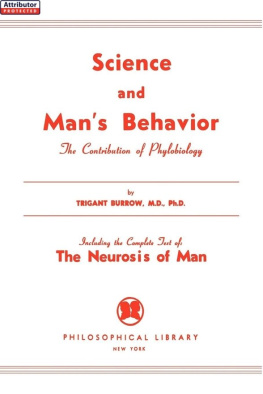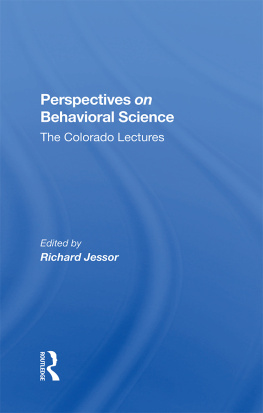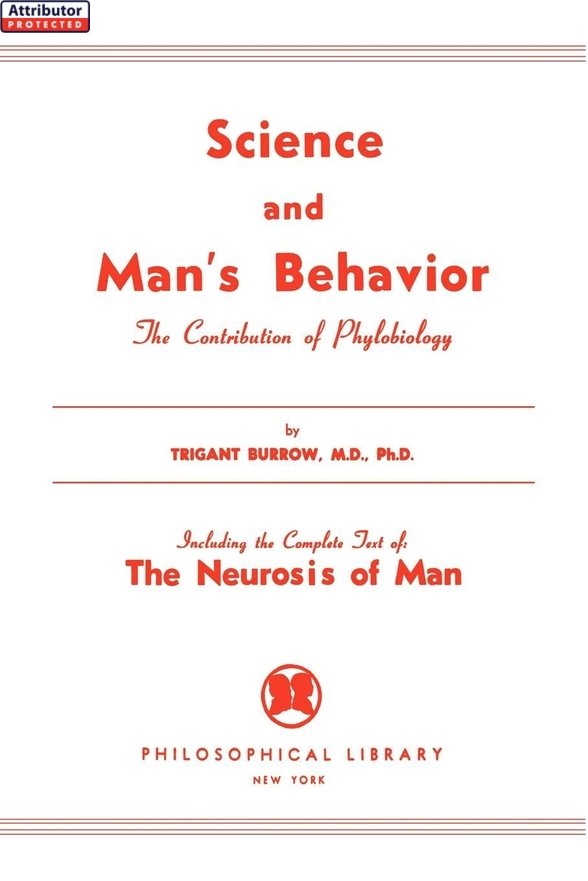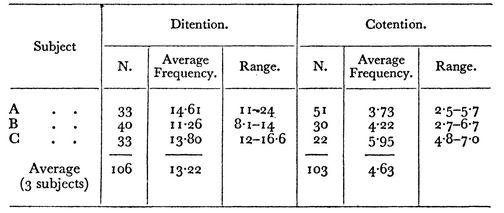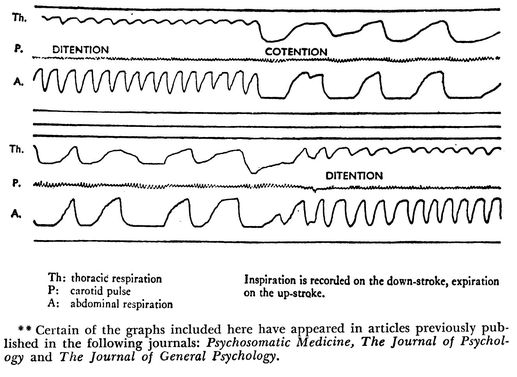APPENDIX
The following pages dealing with instrumental measures under conditions of ditention and cotention give in detail the experimental procedures followed, and the results obtained in respect to three major physiological systems of the organismthe respiratory, oculomotor and cerebral spheres of reaction.
Respiratory Changes
I shall first describe the modifications in the respiratory function that accompanied the shift from the ditentive to the cotentive pattern of behavior. This reaction is first in order of description because it was first in order of experimentation. We selected this system for study for several reasons: (1) It is the organic reaction-system that is most plainly observable; (2) this system readily permits of instrumental recording; (3) the respiratory function plays an important role in mediating mans interchange through speech, or through his socio-symbolic system; (4) respiratory changes are an unfailing accompaniment of affecto-symbolic disorders, both normal and neurotic (consider the respiratory disturbances displayed in the psychoneuroses); and (5) the respiratory system is innervated by fibres from both the cerebrospinal and the sympathetic or autonomic centers, and hence serves a dual function in mediating between the organism and the environment.
The slowed respiratory rhythm that I observed in myself in periods of cotention was amply corroborated by my assistants who, in addition to making observations upon themselves, made careful note of the respiratory alterations observable in each other during cotention. Naturally the observation of this unexpected phenomenon led to our interest in undertaking the more precise study of this reaction as well as to the hope of discovering in ourselves other physiological modifications that might lend themselves to instrumental recording.
Several series of experiments were conducted on the relationship of the respiratory function to the two attentional modes. The first series of respiratory records was taken in 1937 at the summer research station of The Lifwynn Foundation. In this series and in a later extension of it, the instrument used for recording the respiratory curves was the wax-paper kymograph constructed by Volkmann and Gerbrands at the Harvard Psychological Laboratory, the apparatus having been specially adapted to our purposes. This instrument is electrically driven and permits the taking of continuous records over a period of several hours. Tracings were obtained of the thoracic and of the abdominal respiration by means of rubber-tube pneumographs, and of the carotid pulse by means of a Lombard tambour. The time was registered on the record in intervals of five seconds and there were two signal-markers, one for the subject and one for the experimenter.
Sixteen individuals, eight males and eight females, ranging in age from 17 to 63 years, served as subjects in the first group of experiments. The experimental periods varied from thirty minutes to two hours. With a few individuals the experiments were repeated many times and with several experimental variations, whereas the records of other subjects served chiefly for determining the average conformation of the respiratory curves.
In seven subjects the reaction I have described as cotention was specially investigated. The data are presented for those three subjects on whom most numerous records were obtained. The combined data for the three subjects include respiratory curves for 103 minutes of cotention (56 periods varying from one to ten minutes), and these were compared with 106 one-minute samples of the subjects respiration during ditention.. In one subject the inspiration-expiration ratio was markedly decreased, that is, the expiration was disproportionately prolonged; but this marked change did not appear so definitely in other subjects. Incidentally, the pulse rate did not show any changes that were statistically reliable.
It should be noted that these respiratory alterations set in immediately with the alteration of the attentional pattern. They occurred automatically and were not brought about by voluntary control or conscious effort. Control experiments showed that the respiratory changes, as they occur in cotention, do not show any similarity to the slight modifications in respiration observed in sleep and sleepiness, in mental effort, emotional excitement, or under conditions in which the subject focuses upon external objects or upon bodily tensions in regions other than those of the symbolic segment. It was interesting that in control periods immediately following cotention there was no compensatory acceleration in the breathing rate above the normal level. On the other hand, when subjects were instructed to retard consciously the frequency of respiration, there was invariably a compensatory acceleration in respiratory rate in subsequent control periods.
A VERAGE F REQUENCY AND R ANGE OF R ESPIRATORY R ATE IN D ITENTION AND IN C OTENTION
**.Typical Respiratory and Pulse Curves during Successive Periods of Ditention and Cotention.
In a second series of experiments on the same three subjects, respiratory measurements were taken with the Jones basal metabolism apparatus. These observations were made under the direction of Dr. Henry B. Turner in the medical laboratory of the Guardian Life Insurance Company, New York. The procedure adopted was that ordinarily employed in basal metabolism tests. With this method dependable spirometric curves were obtained. All tests were made in the early morning before the subjects had had any food. The subjects rested in a supine position for one half hour, before each test. We shall first present only those results which may serve as a control and amplification of the experimental series on respiration just reported. The findings on basal metabolism will be reported in subsequent pages.
A glance at For all three subjects the frequency of respiration was markedly lower in cotention than in ditention. By combining the data for the three subjects, we compared 239 minutes of cotention in 56 periods, ranging from two to five minutes each, with 249 minutes of ditention comprising 64 periods of three and four minutes each. The respiratory rate dropped from an average of 9.7 movements per minute for the three subjects in ditention to an average of 2.6 in the cotentive periods. Again there was no overlapping for any one of the three subjects in the distribution of the respiratory rates in ditention and cotention. There can be no question, therefore, as to the validity of the difference in rate under the two conditions.
The records obtained from the basal metabolism apparatus made it possible to secure additional respiratory data, namely, the minute-volume of air inspired, the tidal air, and the oxygen-utilization of the subjects. The minute-volume was calculated by measuring the individual inspiratory strokes through a specified portion of the experimental periods and adding the figures obtained. As it is known what amount of air-volume a specified length of amplitude represents, the minute-volume may be directly calculated from the basal metabolism charts. This procedure is laborious but it is more exact than merely determining the mean respiratory amplitude and multiplying it by the respiratory rate. It will be seen from that in all three subjects the minute-volume in cotention was markedly less than in ditention. If we pool the results we find that the average minute-volume of air inspired by the three subjects dropped from 6.95 litres in ditention to 4.08 litres in cotention. As there was no overlapping in the distribution of minute-volumes during cotention and ditention for any of the three subjects, again there can be no question as to the validity of the difference in minute-volumes under the two experimental conditions.

